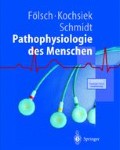Zusammenfassung
Fall 1. Der achtjährige Junge entwickelte plötzlich kurze, etwa 10 Sekunden dauernde Aussetzer, die mehrere hundert Male pro Tag auftraten. Sie fielen zunächst in der Schule auf, da die Aufmerksamkeitsstörungen dort besonders deutlich wurden. Abb. 31.1 zeigt eine typische Absence im Videodoppelbild mit EEG, das hochgespannte 3/s spike wave-Abläufe zeigt. Gleichzeitig fand sich beim Patienten eine Bulbusdeviation nach oben und eine Verharr-Reaktion. Der Patient wurde innerhalb weniger Tage völlig anfallsfrei, nachdem das Antikonvulsivum Valproinsäure eindosiert wurde. Einschränkungen der Intelligenz oder sonstige kognitive Einschränkungen lagen vor oder nach Therapiebeginn nicht vor. Mit Ende der Pubertät wurde die Medikation ausgeschlichen und der Patient blieb anfallsfrei. Es handelt sich um eine auf einen bestimmten Lebensabschnitt begrenzte, gut therapierbare, monosymptomatische Epilepsie, die als Absence-Epilepsie des Schulalters oder Pyknolepsie bezeichnet wird. Sie betrifft das ganze Gehirn (generalisierte Epilepsie) und wird zumindest teilweise durch genetische Faktoren verursacht.
Access this chapter
Tax calculation will be finalised at checkout
Purchases are for personal use only
Preview
Unable to display preview. Download preview PDF.
Literatur
Bradford HF (1995) Glutamate, GABA and epilepsy. Prog Neurobiol 47: 477–511
Dingledine R, McBain CJ, McNamara JO(1990) Excitatory amino acid receptors in epilepsy. TIPS 11: 334–8
Doose H (1998) Epilepsien im Kindes- und Jugendalter. Desitin Arzneimittel (erhältlich über epi.info@desitin.de)
Engel J (ed) (1987) Surgical treatment of the Epilepsies. Raven Press, New York
Grisar TM (1986) Neuronglia relationships in human and experimental epilepsy: a biochemical point of view. Adv Neurol 44: 1045–73
Hauser WA, Hesdorffer DC (1990) Epilepsy: frequency, causes and consequences. Epilepsy Foundation of America. Demos Publications, New York
Heinemann U (1987) Basic mechanisms of the epilepsies. In: Halliday AM, Butler SR, Chichester PR (eds) A textbook of clinical neurophysiology. John Wiley & Sons, New York Brisbane Toronto Singapore, pp 497–534
Marescaux C, Vergnes M, Depaulis A (1992) Genetic absence epilepsy in rats from Strasbourg — a review. J Neural Transm Suppl 35: 37–69
Meldrum BS (1994) The role of glutamate in epilepsy and other CNS disorders. Neurol 44 (supp 8): 14–23
Pellegrini-GiampietroDE, Gorter JA, Bennett MV, Zukin RS (1997) The GluR2 (GluR-B) hypothesis: Ca2 + -permeable AMPA receptors in neurological disorders. TINS 20: 464–70
Poeck K, Hacke W (1998) Neurologie, 10. Auflage. Springer, Berlin Heidelberg New York
Prince DA, Salin P, Tseng GF, Hoffman S, Parada I (1997) Axonal sprouting and epileptogenesis. Adv Neurol 72: 1–8
Represa A, Niquet J, Pollard H, Khrestchatisky M, Ben-Ari Y (1994) From seizures to neo-synaptogenesis: intrinsic and extrinsic determinants of mossy fiber sprouting in the adult hippocampus. Hippocampus 4: 270–274
Shorvon S, Dreifuss F, Fish D, Thomas D (eds) (1996) The Treatment of Epilepsy. Blackwell Science Ltd, Oxford London Edinburgh Cambridge Carlton Victoria
Sommer W (1998) Erkrankung des Ammonshorns als aetiologisches Moment der Epilepsie. Arch Psychiatr Nervenkr 10: 631–675
Waiden J, Speckmann EJ (1993) Elementarprozesse epileptischer neuronaler Aktivität. In: Waiden J, Witte OW, Speckmann EJ (Hrsg) Epileptische Anfälle — Entstehung und Therapie. Springer, Berlin Heidelberg New York, pp 1–9
Wolf HK et al. (1993) Surgical pathology of temporal lobe epilepsy. Experience with 216 cases. J Neuropathol Exp Neurol 52: 499–506
Wyllie E (ed) (1993) The Treatment of Epilepsy: Principles and Practice, 2nd ed. Williams & Wilkins, Baltimore Philadelphia London Paris Bangkok Buenos Aires Hong Kong Munich Sydney Tokyo Wroclaw
Rights and permissions
Copyright information
© 2000 Springer-Verlag Berlin Heidelberg
About this chapter
Cite this chapter
Elger, C.E., Beck, H. (2000). Anfallserkrankungen. In: Pathophysiologie. Springer Lehrbuch. Springer, Berlin, Heidelberg. https://doi.org/10.1007/978-3-642-57115-2_31
Download citation
DOI: https://doi.org/10.1007/978-3-642-57115-2_31
Publisher Name: Springer, Berlin, Heidelberg
Print ISBN: 978-3-642-63004-0
Online ISBN: 978-3-642-57115-2
eBook Packages: Springer Book Archive

